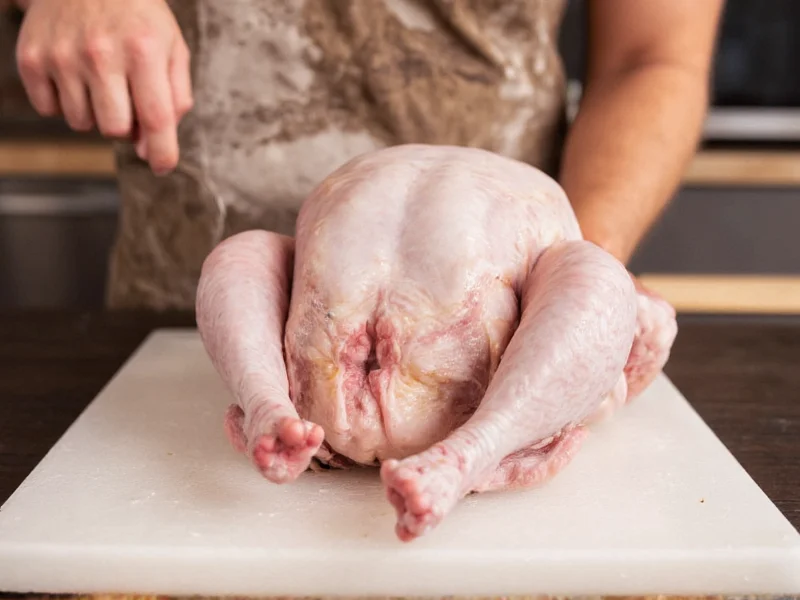Cleaning a turkey properly is essential for food safety and optimal cooking results. Many home cooks make critical mistakes during this process that can lead to foodborne illness or affect the final dish. This comprehensive guide provides professional techniques for safely preparing your turkey while following current food safety recommendations from health authorities.
Why Proper Turkey Cleaning Matters
Improper turkey handling causes thousands of foodborne illness cases annually. Raw poultry contains harmful bacteria like salmonella and campylobacter that can spread through improper cleaning techniques. The USDA reports that nearly 70% of foodborne illness outbreaks during holiday seasons stem from incorrect poultry preparation. Following verified cleaning procedures protects your family while ensuring your turkey cooks evenly and develops perfect texture.
Essential Safety Preparations Before Cleaning
Before touching your turkey, gather these items:
- Disposable gloves (recommended)
- Dedicated plastic or stainless steel container (never use your sink)
- Plenty of paper towels (avoid cloth towels which spread bacteria)
- Separate cutting board for poultry
- Food-safe thermometer
- Bleach-based cleaner for surface sanitation
Designate a specific area for turkey preparation that's away from other foods. Remove jewelry and ensure fingernails are clean and short. The CDC recommends washing hands for 20 seconds with warm water and soap before beginning any food preparation.
Step-by-Step Turkey Cleaning Process
Follow these professional steps for safe turkey preparation:
Step 1: Remove Packaging Safely
Carefully open the turkey packaging over your designated container, not the sink. Many store-bought turkeys contain plastic or paper giblet bags inside the body cavity. Check both the main cavity and neck area thoroughly. If you find frozen giblets still inside a wrapped package, remove them immediately—never cook giblets while still sealed in plastic.
Step 2: Conduct Initial Inspection
Examine your turkey for any remaining pin feathers or discoloration. Small tweezers work best for removing stubborn feathers. Check that the skin remains intact without tears that could harbor bacteria. Discard any turkey with strong odors, slimy texture, or unnatural coloration.
| Common Turkey Problems | Safe Resolution |
|---|---|
| Frozen giblets inside plastic | Remove immediately; never cook sealed plastic |
| Pin feathers remaining | Use tweezers for careful removal |
| Discolored skin areas | Cut away affected portions |
| Strong ammonia smell | Discard entire turkey |
Step 3: Proper Rinsing Technique
Place the turkey in your dedicated container. Gently rinse both cavities and exterior under cold running water for no more than 15 seconds total. Excessive rinsing actually spreads bacteria through water splatter. The USDA confirms that thorough cooking destroys bacteria more effectively than rinsing, but proper rinsing removes visible contaminants.
Step 4: Drying for Optimal Results
Pat the turkey completely dry with paper towels—this critical step improves browning during cooking. Replace towels frequently during the process to avoid recontaminating the bird. For extra-crispy skin, place the dried turkey on a rack in the refrigerator uncovered for 8-12 hours before cooking.
Step 5: Giblet Handling Protocol
If you plan to use the giblets for gravy, rinse them separately in their own container. Never place raw giblets directly in your sink. Cook giblets to 165°F (74°C) before using in recipes. Discard any giblets showing discoloration or strong odors.
Three Critical Mistakes to Avoid
Even experienced cooks make these dangerous errors:
- Sink Washing: Never clean turkey directly in your sink. Bacteria can travel up to 3 feet from splashing water, contaminating countertops, dishes, and utensils.
- Over-Rinsing: Extended rinsing spreads bacteria without providing additional safety benefits. The CDC reports that 60% of home cooks rinse poultry for too long.
- Reusing Towels: Using the same paper towel for multiple tasks transfers bacteria throughout your kitchen.
Post-Cleaning Sanitation Protocol
After handling raw turkey, immediately:
- Wash hands with soap for 20 seconds
- Sanitize all surfaces with a bleach solution (1 tablespoon bleach per gallon of water)
- Wash cutting boards in dishwasher or with hot soapy water
- Discard paper towels used during preparation
- Run empty dishwasher on hottest setting if used
Remember that bacteria from raw turkey can survive on surfaces for up to 32 hours. The FDA recommends sanitizing all contact surfaces twice during turkey preparation.
Advanced Tips for Perfect Results
Professional chefs use these techniques for superior outcomes:
- For easier giblet removal, partially thaw turkey in refrigerator before cleaning
- Use a dedicated poultry prep kit stored separately from other kitchen tools
- Place a clean towel beneath your container to absorb splashes
- Consider dry-brining after cleaning for enhanced flavor and texture
- Always use a food thermometer to verify internal temperature reaches 165°F











 浙公网安备
33010002000092号
浙公网安备
33010002000092号 浙B2-20120091-4
浙B2-20120091-4